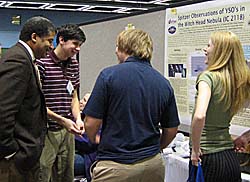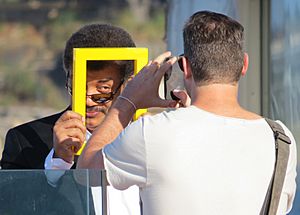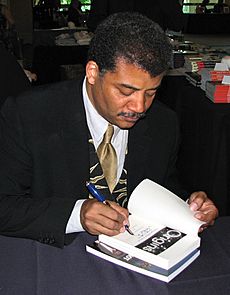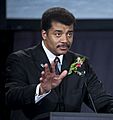Neil deGrasse Tyson facts for kids
Quick facts for kids
Neil deGrasse Tyson
|
|
|---|---|

Tyson in 2023
|
|
| Born | October 5, 1958 New York City, U.S.
|
| Education | |
| Spouse(s) |
Alice Young
(m. 1988) |
| Children | 2 |
| Awards |
|
| Scientific career | |
| Fields | |
| Institutions | |
| Thesis | A Study of the Abundance Distributions Along the Minor Axis of the Galactic Bulge (1992) |
| Doctoral advisor | R. Michael Rich |
| YouTube information | |
| Years active | 2010–present |
| Subscribers | 4.57 million |
| Total views | 740.1 million |
| Subscriber and view counts updated as of April 25, 2025. | |
| Signature | |
 |
|
Neil deGrasse Tyson (born October 5, 1958) is a famous American astrophysicist, author, and science communicator. He helps people understand the wonders of the universe.
Tyson studied at top universities like Harvard University and Columbia University. Since 1996, he has been the director of the Hayden Planetarium in New York City. This planetarium is part of the American Museum of Natural History. He even helped lead a huge $210 million project to rebuild the planetarium, which finished in 2000.
He has written many popular books about space, like Astrophysics for People in a Hurry. He also hosted TV shows such as NOVA ScienceNow and Cosmos: A Spacetime Odyssey. This Cosmos series was a new version of the classic show by Carl Sagan. For his amazing work in sharing science with the public, he received the Public Welfare Medal in 2015.
Contents
Neil Tyson's Early Life and School
Neil Tyson was born in Manhattan, New York City, and grew up in the Bronx. His father was a sociologist, and his mother was a gerontologist. Neil has two siblings. His middle name, deGrasse, comes from his grandmother.
He went to public schools in the Bronx and graduated from The Bronx High School of Science in 1976. He was the wrestling team captain and edited the Physical Science Journal.
How Neil Tyson Got Interested in Space
Neil's interest in astronomy started when he was nine years old. He visited the sky theater at the Hayden Planetarium. He said that experience made him feel like the universe was calling him.
During high school, he took astronomy classes at the Hayden Planetarium. He called this time "the most formative period" of his life. He looked up to Mark Chartrand III, the planetarium's director, who inspired him to share science with others.
When he was 14, he got a special scholarship. This allowed him to see a total solar eclipse in 1973 from a ship. Famous people like Neil Armstrong and Isaac Asimov were also on that trip.
Carl Sagan's Influence on Neil Tyson
Neil studied astronomy a lot as a teenager. By age 15, he was already giving lectures about it. The famous astronomer Carl Sagan from Cornell University noticed him. Sagan even invited the 17-year-old Tyson to visit him in Ithaca, New York.
Tyson shared this story on his TV show Cosmos: A Spacetime Odyssey. He said that Carl Sagan offered him a place to stay if his bus home didn't come. Tyson realized then what kind of person he wanted to become as a scientist.
Neil Tyson's College and University Years
Tyson chose to go to Harvard University for his undergraduate studies. He studied physics there and was part of the rowing and wrestling teams. He also enjoyed dancing.
He earned his Bachelor of Arts degree in physics from Harvard in 1980. Then, he went to the University of Texas at Austin and received a Master of Arts degree in astronomy in 1983.
Later, he joined Columbia University for his advanced degrees. He earned a Master of Philosophy degree in astrophysics in 1989. In 1991, he completed his PhD in astrophysics. His research involved observing stars in distant galaxies.
Neil Tyson's Career in Science
Neil Tyson's work has focused on studying the universe, how stars change, and how galaxies are formed. He has worked at several important places, including Princeton University and the American Museum of Natural History.
In 1994, he joined the Hayden Planetarium as a staff scientist. He became the director in 1996. He led the huge project to rebuild the planetarium, which finished in 2000. Tyson felt it was his duty to inspire new generations, just as others had inspired him.
Neil Tyson as a Writer and Public Speaker
Tyson has written many popular books about space science. From 1995 to 2005, he wrote a monthly column called "Universe" for Natural History magazine. Some of these essays became parts of his books.
He also wrote a column for StarDate magazine, answering questions about the universe. He even came up with the term "Manhattanhenge" in 1996. This describes when the setting sun lines up perfectly with the streets of Manhattan twice a year. It's like the sun's alignment with Stonehenge in England.
Neil Tyson's Role in Government and Space Policy
In 2001, U.S. President George W. Bush asked Tyson to join a special group. This group looked at the future of the U.S. aerospace industry. In 2004, he was on another group called the "Moon, Mars, and Beyond" commission.
Soon after, NASA gave him their highest award for civilians, the NASA Distinguished Public Service Medal.

In 2004, Tyson hosted a four-part TV series called Origins for PBS. He also co-wrote a book for the series. He later narrated a documentary called 400 Years of the Telescope in 2009.
The Pluto Debate
As director of the Hayden Planetarium, Tyson made a bold choice. He decided not to call Pluto the ninth planet in the planetarium's exhibits. He wanted to group planets by their features, not just count them. He grouped rocky planets together, gas giants together, and Pluto with other similar icy objects.
He has said that this decision led to a lot of angry letters, especially from children. In 2006, the International Astronomical Union (IAU) officially changed Pluto's status to a dwarf planet. This confirmed Tyson's earlier decision.
Tyson was also a leader in the Planetary Society. He hosted the PBS show Nova ScienceNow until 2011.
In 2009, Tyson started a radio show and podcast called StarTalk. He co-hosted it with comedians. Guests on the show include scientists and celebrities. The show is very popular and is available as a podcast.
In 2014, Tyson hosted Cosmos: A Spacetime Odyssey. This TV series was a follow-up to Carl Sagan's famous 1980 series. It aired on FOX and the National Geographic Channel. A second season, Cosmos: Possible Worlds, aired in 2020.
In 2015, Tyson started hosting a late-night talk show, also called StarTalk, on the National Geographic Channel. On this show, he interviews celebrities about their experiences with science.
Neil Tyson's Views on Life and Science
Science and Belief
Tyson has often shared his thoughts on science, spirituality, and how they connect. He believes that science helps us understand the universe in a deep, emotional way. He has said that some historical scientists' beliefs in "intelligent design" (the idea that a higher power designed life) sometimes limited their scientific discoveries.
When asked if he believes in a higher power, Tyson has said he finds it hard to believe in a benevolent power when the universe has so many ways to harm us. He describes himself as an "agnostic." This means he doesn't claim to know if a higher power exists or not. He prefers not to be put into any specific category.
Tyson has also talked about philosophy. In 2014, he said that philosophy can be "useless," which caused some debate.
Neil Tyson on Fairness and Equality
In 2005, Tyson spoke about why there aren't more women or Black people in science. He said that society often creates barriers. He believes that before we talk about differences, we need to make sure everyone has equal opportunities.
He has also supported the rights of gay and transgender people.
Neil Tyson's Support for NASA
Tyson strongly believes that NASA (the National Aeronautics and Space Administration) should get more funding. He argues that NASA inspires a nation's dreams but is not given enough money.
He often points out that NASA's budget is very small. He says it's "half a penny on the dollar" of tax money. He believes that doubling this to "a penny on a dollar" could greatly inspire the country. His ideas even inspired a campaign called Penny4NASA, which aims to increase NASA's budget.
In his book Space Chronicles, Tyson suggests that big space projects, like sending humans to Mars, might need a strong reason like military or economic benefits to get enough funding from the government.
Neil Tyson in Media
Neil Tyson often appears on TV, radio, and other media to talk about science. He has been a guest on many popular shows like The Colbert Report and The Daily Show with Jon Stewart. He has also appeared on late-night talk shows.
He was a central expert on the History Channel's science program, The Universe. He has also been a guest on radio quiz shows and podcasts.
Tyson lived near the World Trade Center and saw the September 11, 2001, attacks. He wrote a widely shared letter about what he saw, and his video footage was used in a documentary.
He has given many speeches, emphasizing how important science is for the future. He was a keynote speaker at The Amazing Meeting, a science and skepticism conference.
Tyson has made guest appearances as himself in TV shows like Stargate Atlantis and The Big Bang Theory. He also appeared in the film Batman v Superman: Dawn of Justice.
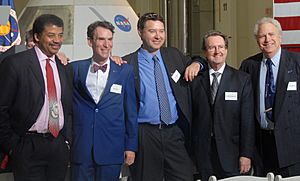
In 2012, Tyson appeared in a YouTube series based on his StarTalk radio show. He was also a celebrity guest at the White House Student Film Festival in 2014.
In 2013, Tyson helped DC Comics choose a real star for Superman's home planet, Krypton. He picked the red dwarf star LHS 2520 in the constellation Corvus.
He has also narrated and been a script supervisor for the science documentary Food Evolution (2016). Tyson has even made guest appearances on music albums, including for Avenged Sevenfold and Logic.
He has appeared in many animated shows like Gravity Falls, Family Guy, BoJack Horseman, and The Simpsons.
Neil Tyson's Personal Life
Neil Tyson lives in Lower Manhattan with his wife, Alice Young. They have two children, Miranda and Travis. He met his wife in a physics class. They named their first child Miranda after the smallest of Uranus' five major moons.
Tyson is also a big fan of wine. His wine collection has been featured in magazines.
Awards and Honors
Neil Tyson has received many awards and honors for his contributions to science and public education.
Awards
- 2001 Medal of Excellence, Columbia University
- 2004 NASA Distinguished Public Service Medal
- 2005 Science Writing Award
- 2007 Klopsteg Memorial Award
- 2009 Douglas S. Morrow Public Outreach Award (for sharing space programs with the public)
- 2009 Isaac Asimov Award
- 2014 Critics' Choice Television Award for Best Reality Show Host
- 2014 Dunlap Prize
- 2015 Public Welfare Medal from the National Academy of Sciences
- 2015 Cosmos Award, Planetary Society
- 2017 Hubbard Medal, National Geographic Society
- 2017 Stephen Hawking Medal for Science Communication
- 2018 Grammy Award for Best Spoken Word Album nomination for Astrophysics for People in a Hurry
- 2020 YouTube Gold Creator Award
Honors
- 2001 An asteroid was named after him: 13123 Tyson
- 2001 The Tech 100, one of the 100 most influential technology leaders in New York
- 2004 Fifty Most Important African-Americans in Research Science
- 2007 The Time 100, one of the 100 most influential people in the world
- 2008 Discover Magazine named him one of "The 10 Most Influential People in Science"
- 2010 Elected a Fellow of the American Physical Society
Honorary Doctorates
Tyson has received many honorary doctorates from universities across the United States. These are special degrees given to people who have achieved great things.
Species Named After Him
- 2016 The leaping frog Indirana tysoni was named after him.
Neil Tyson's Film and TV Appearances
Film
| Year | Title | Role | Notes |
|---|---|---|---|
| 2016 | Zoolander 2 | Himself | |
| Batman v Superman: Dawn of Justice | |||
| Lazer Team | |||
| Ice Age: Collision Course | Neil deBuck Weasel | Voice | |
| Food Evolution | Narrator | Documentary | |
| 2018 | The Last Sharknado: It's About Time | Merlin | Television film |
| 2024 | This Is Me... Now: A Love Story | Taurus |
Television
| Year | Title | Role | Notes |
|---|---|---|---|
| 2006–2011 | Nova ScienceNow | Host | |
| 2008 | Stargate: Atlantis | Himself | Episode: "Brain Storm" |
| 2010 | NOVA | Host | Episode: "The Pluto Files" |
|
The Big Bang Theory | Himself | 2 episodes: "The Apology Insufficiency" "The Conjugal Configuration" |
| 2012 | Martha Speaks | Episode: "Eyes on the Skies" | |
| 2012 | The Inexplicable Universe: Unsolved Mysteries | 6-part lecture series from The Great Courses | |
| 2014 | Cosmos: A Spacetime Odyssey | Host | |
| 2014 | Gravity Falls | Waddles | Episode: "Little Gift Shop of Horrors" |
| 2015 | Brooklyn Nine-Nine | Himself | Episode: "The Swedes" |
|
Family Guy | 2 episodes: "Scammed Yankees" "Prescription Heroine" |
|
| 2015–2019 | StarTalk | Host | |
| 2016 | BoJack Horseman | Planetarium Narrator | Episode: "That's Too Much, Man!" |
| 100 Things to Do Before High School | Himself | Episode: "Meet Your Idol Thing!" | |
| Future-Worm! | Episode: "Long Live Captain Cakerz!" | ||
| The Jim Gaffigan Show | Episode: "Jim at the Museum" | ||
| Regular Show | Episode: "Terror Tales of The Park VI" | ||
| Mars | |||
| 2017 | The Simpsons | Episode: "The Caper Chase" | |
| Super Science Friends | Episode: "Nobel of the Ball" | ||
| 2018 | Last Week Tonight with John Oliver | 2 episodes | |
| 2020 | Scooby-Doo and Guess Who? | Episode: "Space Station Scooby!" | |
| Cosmos: Possible Worlds | Host | Documentary | |
| 2023 | Pantheon | Dr. Moore (voice) | Episode: "Apokalypsis" |
| 2024 | Futurama | Himself | Episode: "The Futurama Mystery Liberry" |
| 2025 | Celebrity Jeopardy! | Himself (Contestant) |
Other Media Appearances
| Year | Title | Role | Notes |
|---|---|---|---|
| 2017 | Futurama: Worlds of Tomorrow | Himself | Mobile app game |
Neil Tyson's Discography
| Title | Year | Artist(s) | Album |
|---|---|---|---|
| "Exist" | 2016 | Avenged Sevenfold | The Stage |
| "AfricAryaN" | 2017 | Logic | Everybody |
Books by Neil Tyson
- Merlin's Tour of the Universe (1989)
- Universe Down to Earth (1994)
- Just Visiting This Planet (1998)
- One Universe: At Home in the Cosmos (2000)
- Cosmic Horizons: Astronomy at the Cutting Edge (2000)
- City of Stars: A New Yorker's Guide to the Cosmos (2002)
- My Favorite Universe (a 12-part lecture series) (2003)
- Origins: Fourteen Billion Years of Cosmic Evolution (co-authored with Donald Goldsmith) (2004)
- The Sky Is Not the Limit: Adventures of an Urban Astrophysicist (2004)
- Death by Black Hole: And Other Cosmic Quandaries (2007)
- The Pluto Files: The Rise and Fall of America's Favorite Planet (2009)
- Space Chronicles: Facing the Ultimate Frontier (2012)
- Welcome to the Universe: An Astrophysical Tour (co-authored with Michael A. Strauss and J. Richard Gott) (2016)
- Astrophysics for People in a Hurry (2017)
- Accessory to War: The Unspoken Alliance Between Astrophysics and the Military (2018, with Avis Lang)
- Letters from an Astrophysicist (2019)
- Cosmic Queries: StarTalk's Guide to Who We Are, How We Got Here, and Where We're Going (2021)
- Starry Messenger: Cosmic Perspectives on Civilization (2023)
- To Infinity and Beyond: A Journey of Cosmic Discovery (2023). Coauthored with Lindsey Nyx Walker.
Images for kids
-
Tyson hosting the 40th anniversary celebration of Apollo 11 at the National Air and Space Museum in Washington, July 2009
See also
 In Spanish: Neil deGrasse Tyson para niños
In Spanish: Neil deGrasse Tyson para niños


